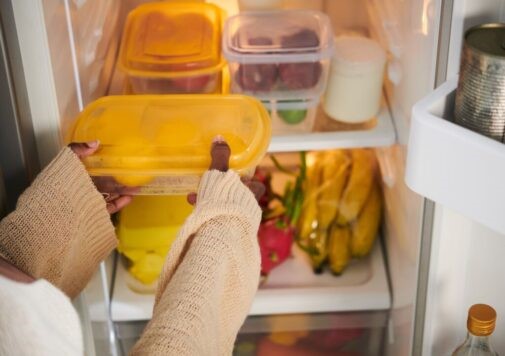Are You Storing Leftovers Safely?

Whether you prep meals like a pro or you overestimated how much pasta to make, storing food is unavoidable. But are you doing it safely?
As sustainability experts, we recommend that you follow these tips to safely store your food:
1. Choose the right storage containers
Look for containers that are airtight and food grade. If made from plastic, check for a “BPA-free” label. BPA, or Bisphenol A, is a chemical found in hard plastics. It is a known endocrine disruptor, according to the National Institute of Environmental Health Sciences. Many manufacturers have since removed BPA from their products. You should also avoid containers with recycling codes 3, 6 or 7, per the American Academy of Pediatrics‘ recommendations. Containers with these codes contain phthalates, styrene and bisphenols, respectively.
2. Use and care for plastic containers properly
Recycling code 1 indicates single-use plastic, such as disposable water bottles. These plastics are only designed to be used once, so repeated use is generally not advised. Microwaving, dishwashing or exposing plastic containers to any kind of prolonged sunlight may damage them, causing them to leach chemicals into food or liquid. Reheat leftover food in a microwave-safe container when possible. Handwashing plastic containers limit heat exposure and can prolong its lifespan.
3. Replace as needed and recycle when possible
The lifespan of a plastic container depends on its use. If a plastic container has been repeatedly exposed to high heat, is cracked, stained or otherwise damaged, it might be time to replace. While washing, look for signs of damage and lids that no longer seal properly. Many plastic containers can be recycled, so be sure to recycle them appropriately at the end of their lifespan. Not sure how to recycle them? Check with your local municipality’s guidelines.
4. Use plastic alternatives when possible
Did you know you swallow about five grams of microplastics every week? Most plastics do not biodegrade. Instead, they break down into increasingly smaller microplastics, which are digested by humans and wildlife, according to a study commissioned by the World Wildlife Fund. To reduce your plastic use and waste, consider non-plastic alternatives, such as glass or stainless-steel containers. Cling wrap and plastic zip-lock bags can be swapped with reusable silicone bags, sustainably sourced beeswax wrap, or cloth or net produce bags. These alternatives may cost more up front but may end up saving you money with their longer lifespans.
Overall, these precautions will help you store leftovers properly to help keep you and your family safe.
Contributed by: Travis Hawks and Erika Ninos, sustainability managers with Advocate Health Care and Aurora Health Care.
Tags: #foodstorage, #leftovers, #leftoverstorage, #parishnurse, #sustainability


Comments are closed here.